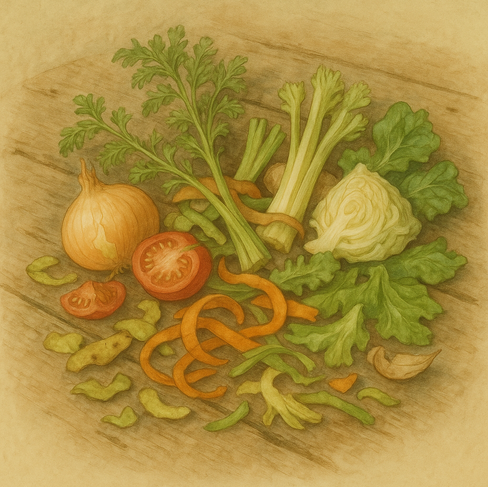Composting: Turning Scraps Into Soil Gold
- The Fleur Kitchen

- May 8
- 3 min read
Updated: May 25
To grow good plants, you need good soil. You can buy this, however, you have in your kitchen what you need for the start of this!
Composting is one of those quiet little acts that makes a big difference. It’s simple, sustainable, and surprisingly satisfying —turning kitchen peelings and garden clippings into rich, crumbly compost that your plants will absolutely adore.
At The Fleur Kitchen, composting is a key part of how we garden. It closes the loop, cuts down on waste, and gives us something far more useful than a full bin bag. And once you get into the rhythm of it, it becomes second nature, just another part of the growing cycle.
Here’s our gentle guide to getting started with composting at home:
What Is Composting, Really?
Composting is nature’s way of recycling. You take all the bits and bobs you don’t eat - fruit and veg peelings, garden clippings, tea leaves, eggshells and let them break down naturally into a rich, earthy material that feeds your soil.
In short: you feed the soil, the soil feeds the plants, and the plants feed you. Lovely, isn’t it?
What Can You Compost?
Here’s what goes in our compost bins:
Greens (wet materials):
Vegetable scraps and fruit peelings
Coffee grounds and tea bags (make sure they’re plastic-free!)
Grass clippings
Fresh plant trimmings
Egg shells.
Browns (dry materials):
Cardboard (think loo roll tubes, egg boxes, and brown parcels)
Paper towels and napkins (plain, no prints)
Fallen leaves
Straw and wood shavings
Shredded paper (no glossy pages)
Aim for a good balance. Roughly 50% green, 50% brown. Too many greens and it’ll go sludgy. Too many browns and it’ll dry out. You’re aiming for a soft, spongey texture - not too wet, not too dry.
What Not to Compost
Some things just don’t belong in the compost heap:
Cooked food and meat (they attract the wrong kind of visitors)
Dairy products
Glossy or coloured paper
Citrus peel (in moderation is fine, but too much can upset the balance)
Weeds that have gone to seed (you don’t want to replant them later!)
Setting Up Your Compost Area
You don’t need anything fancy to start, just a space where the compost can breathe. We use wooden pallet bins at the allotment (built by Ashley, of course) and a lidded compost caddy at home for kitchen scraps.
Here’s what you’ll need:
A compost bin or heap (wooden pallets, plastic bins, or even a simple pile will do)
A spot with a bit of shade and good drainage
A garden fork or compost aerator (for turning the heap every so often)
If you’re tight on space, there are brilliant compact bins and wormeries for small gardens or even balconies.
Tips for Happy Composting
Chop it small: The smaller the pieces, the quicker they break down. Tear, cut, or crush where you can.
Keep it balanced: Alternate greens and browns, like a compost lasagne.
Let it breathe: Turn the heap every 2-3 days whilst it's hot (the compost not the weather) and when it's cooled down once a week to add air.
Be patient: Compost takes time—around 6 to 12 months depending on the weather and your mix.
You’ll know it’s ready when it’s dark, crumbly, and smells like the forest floor. Earthy and rich and not stinky!
Why We Love It
There’s a quiet magic to composting. What once looked like waste becomes life-giving food for your soil. It’s a gentle act of stewardship. A reminder that nothing in nature is wasted, just transformed.
We use our compost to feed raised beds, top up pots, start new no-dig beds, and mulch around hungry plants like courgettes and brassicas. It’s like giving your garden a big, nourishing hug.
In a Nutshell…
Composting is for everyone. Whether you’ve got a big plot or a few pots, you can make space for this simple, powerful practice. It’s one of the easiest ways to care for your garden - and the planet.
So start small, find your rhythm, and let nature do what it does best.
With love (and composty hands),
The Fleur Kitchen











Comments